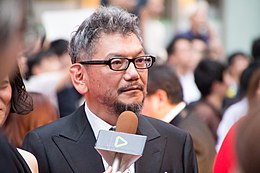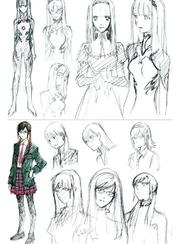Mari Illustrious Makinami
Evangelion: 3.0+1.0 Thrice Upon a Time (2021) revealed more details about Mari, which generated more mixed reviews; some critics noted a lack of explanation of her nature, and others appreciated her psychology and her role in the finale.
[1] Director and main screenwriter Hideaki Anno welcomed the idea as a breath of fresh air which would distance the new films from the original work[2] and give its audience fan service.
[12] Anno's generic guidance complicated the staff's work; assistant director Kazuya Tsurumaki[13] said that Mari seemed to have "multiple personalities" and was a different character in each scene, and it was difficult to make her consistent.
Some ideas were rejected by other staff members and discarded,[19] such as a scene in which Mari and Asuka would fight in the same Evangelion against the eighth Angel in a nininbaori, a Japanese comedic act where two people wear the same large coat and pretend to be one person.
[12] Other possibilities involved Mari meeting Shinji Ikari near a railroad track[23] and drinking tea on the roof of a school; after several drafts, however, her character was still unclear to Anno.
[18] He wanted to have Mari do something bizarre, such as parachute from the sky;[24] her meeting with Shinji was storyboarded just in February 2009, while Tsurumaki and other staff members continued to work close to the deadline.
Enokido, remembering harem anime stereotypes, proposed a fighter like Sapphire in Osamu Tezuka's Princess Knight, so a neutral, carefree and innocent character.
Other ideas were proposed; studio staff suggested that Mari belong to a wealthy English family, owns dogs and cats, and has tattoos of her pets' names.
First giving Mari a long-sleeved jacket inspired by the protagonists in Danny Boyle's 1996 film Trainspotting, he opted for a simple white shirt and tie because of the anime's summer setting.
[38] During the film's early production, a green, indigo, or yellow plug suit was considered;[39] pink, a popular color in the Japanese animation industry, was ultimately chosen to give Mari a more feminine touch.
[41] Sadamoto wanted to make the new plug suit more modern than the green one, taking advantage of technology and noting the differences between the first and second series of the Lotus Elise spyder.
The city is then attacked by the tenth Angel, Zeruel;[60] Mari, unbeknownst to the special agency Nerv, takes control of Evangelion Unit 02, formerly owned by Asuka Langley Shikinami.
[67] In Evangelion 3.0+1.0: Thrice Upon a Time, the final installment of the saga, Mari prepares with Asuka and Shinji at the Wille and they head to the South Pole, the epicenter of the catastrophic Second Impact.
At the end of the battle, Mari has Shinji board the Eva-01 to confront Gendo Ikari; she enters the ship containing Nerv's deputy commander, Kozo Fuyutsuki,[66] and says goodbye to him.
[69] Mari appears in an extra chapter in the last volume of the Neon Genesis Evangelion manga, written and drawn by Yoshiyuki Sadamoto between 1994 and 2013, in which she is introduced as a sixteen-year-old student enrolled at Kyoto University, the same school attended by researcher Yui Ikari, who plays the role of her senpai and spiritual guide.
[71] The artist made it as an homage to Mari and an opportunity to explore unusual aspects of the character, such as her habit of calling Gendo "Gendo-kun" and singing songs from the Showa period, representing as a young woman in love with Yui.
Quest,[82] The Battle Cats,[83] Monster Strike,[84] Tales of Zestiria,[85] Puzzle & Dragons,[86] Million Arthur,[87] Hortensia Saga,[88] Keri hime sweets, Summons Board,[89][90] Othellonia,[91] Final Gear[92][93] and the RPG Kotodaman.
Her eccentric character is reflected in her colloquial, expressive, and ironic way of speaking; in the original version, Mari calls Asuka "princess" (姫, hime) and Shinji Ikari "puppy" (ワンコ君, wanko-kun).
In the battle against the tenth Angel, Anno had Mari say dokkoisho (ドッコイショ) – typical of traditional Sōran Bushi dance, to conveying the idea of an "old man" from the era.
[44] Other songs related to and sung by the character are Mamikazumichi no māchi (真実一路のマーチ) by Suizenji, Sekai ha futari no tameni (世界は二人のために) by Naomi Sagara and Hitori janai no (ひとりじゃないの) by Mari Amachi.
[108] Japanese critic Naoya Fujita, noting that Mari can activate the Beast mode, described her as an "animalistic" character, a symbol of the affirmation of life, humanity, the body, and desire.
[109] He wrote that Mari is "a being who does not suffer from the Christian sense of original sin or modern self-awareness", and compared her sensuality to that of the protagonist of Cutie Honey, a 2004 film directed by Anno.
[134] In The Anime Encyclopedia, Jonathan Clements and Helen McCarthy wrote that Mari seemed to be inserted into the franchise as a "cynical exercise in justifying new action figures" but "making it clear this story was diverging far from the original".
[138] Morgan Lewis of VGCultureHQ, who had favorably reviewed You Can (Not) Advance, disliked Mari because of the fan service and the scene in which she talks to Shinji before he decides to re-board his own Eva detracting from Kaji's character.
Though she plays an important role in two of the movies' big fight scenes, she does not get enough screen time here for viewers to figure out much about her motives or purpose, but she is the breath of fresh air that the franchise needs and helps restore the sense of mystery inherent in the original series.
[144] Chris Homer of The Fandom Post gave Mari an honorable mention in his 2019 list of the ten best British characters in Japanese animation, praising her lighthearted and combative attitude.
[147] Anime News Network's Martin Theron wrote, "She is the breath of fresh air that the franchise needs and helps restore the sense of mystery inherent in the original series".
Some fans were puzzled by the final scene in which Mari takes Shinji's hand in Ube Station; the gesture was interpreted as indicating a romantic relationship between them, contradicting the idea that the young man would get involved with Asuka.
[182] The interactive attraction "Evangelion The Real 4D" was unveiled in 2016 to commemorate the original series' twentieth anniversary, recreating the battle against the tenth Angel from Mari's point of view.
[187] A number of celebrities have cosplayed her, including idol Jurina Matsui, former member of the group AKB48,[188] Airi Shimizu,[189] singer Shoko Nakagawa,[190] First Summer Uika,[191] Tenka Hashimoto,[192] Mea Shimotsuki,[193] Ayana Tsubaki[194] and actress Natsuki Kato.



